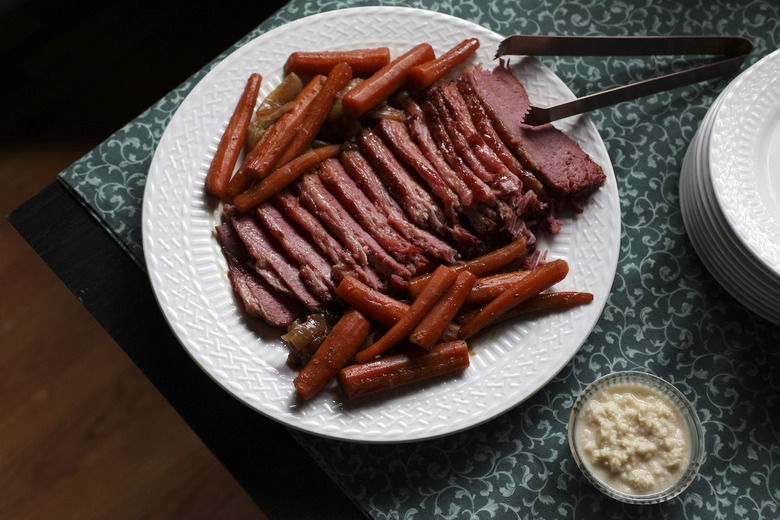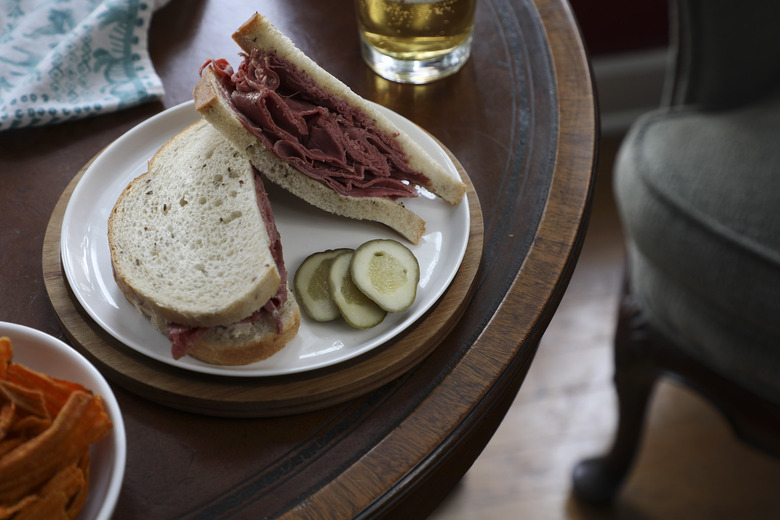Three Corned Beef Recipes That Don't Use Hash Or Cabbage
Corned beef tastes delicious every day of the year, but its popularity soars on Saint Patrick's Day — Irish heritage optional. Like green beer, this holiday food tradition is largely a phenomenon in the United States, with roots that are multicultural in nature.
Is Corned Beef Irish?
Shaylyn Esposito, writing in Smithsonian Magazine, says that traditionally the Irish didn't typically eat beef, instead using cows for their muscle on farms and dairy products; cows were a sacred animal in Gaelic culture.
But the British, who were big beef eaters, exported tens of thousands of cattle every year to Ireland to be raised, slaughtered and exported back to England. The British are credited as the first to corn beef in the 17th century by curing fresh beef with salt for preservation — Irish salt was less expensive than its British counterparts. The term "corned" comes from the large size of the salt kernels used in the curing.
Irish corned beef was exported to Europe and the Americas until the end of the 18th century when the demand declined as the North American colonies produced their own. All the while, Irish peasants could not afford to actually eat the beef they produced.
Then, a million Irish people immigrated to the U.S. during Ireland's Great Famine, frequently landing in New York alongside Jewish immigrants from Eastern and Central Europe. Here, the Irish embraced beef — especially corned beef.
However, Esposito explains that "the corned beef the Irish immigrants ate was much different from that produced in Ireland 200 years prior." Due to prejudices both groups faced, Irish immigrants bought their meat from kosher butchers, and Jewish purveyors used brisket to make corned beef. The Irish took this cut, which was then tossed into a pot with Irish staples like cabbage and potatoes.
Since brisket is a tough cut of beef, it is well suited to the salting and cooking that transforms it into tender, tasty corned beef. This explains why today corned beef can be found in Irish-American households and Jewish delis alike.
What to Do With Corned Beef
Armed with these kernels of knowledge, it's time to get cooking. You can simmer corned beef roasts (sold in cry-o-vac packages in the meat case) with a little Irish stout and fresh orange slices in the oven. The whole house will smell delicious, hopefully providing a pleasant distraction when working in our home offices. At dinner time, a peppery maple glaze will make the whole dish shine.
When time is short, you can channel a delicatessen and simply enjoy a warm corned beef sandwich, made from deli-sliced, fully cooked corned beef on rye bread with zesty horseradish-spiked mayonnaise.
And leftover corned beef tastes great tucked into creamy, cheesy pasta for a warming winter meal no matter where you live.
Maple-glazed Corned Beef With Orange and Stout
If you want something a little bit traditional yet elegant for St. Patrick's Day, this oven-simmered recipe hits all the marks. Irish stout and orange infuse the corned beef with rich flavor, while the sweet, peppery glaze ensures it is far from ho-hum.
For the Maple-glazed Corned Beef With Orange and Stout recipe, click here.
Warm Corned Beef Sandwich With Black Pepper Mayo
A corned beef sandwich may be more delicatessen than Irish, but as discussed above, there has been plenty of cross-cultural exchange when it comes to corned beef. And who can resist this warm sadnwich served on traditional rye and perked up with a horseradish-spiked black pepper mayo?
For the Warm Corned Beef Sandwich With Black Pepper Mayo recipe, click here.
Cheesy Pasta With Caramelized Onions and Corned Beef
Macaroni and cheese may not be the first thing you think of when you think St. Patrick's Day, but this decadent, creamy pasta is the ultimate way to use up any leftover corned beef you may have. And with a mix of cheeses, cream and caramelized onions this isn't your average mac.
For the Cheesy Pasta With Caramelized Onions and Corned Beef recipe, click here.
.


